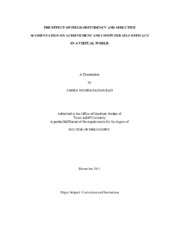| dc.description.abstract | Keeping a learner interested-and therefore engaged-in content to be mastered generally improves learning. One way to keep a learner interested is using seductive augmentation, which refers to the addition of entertaining text, graphics, sound, music, video or animation that is either irrelevant or only tangentially relevant to the learning objectives.
Learner cognitive styles impact how individuals approach learning and problem-solving situations. With recent advances in technology, there has been an increased interest in the way such individual differences influence performance while learning. Research on the effects of cognitive styles has mainly focused on the role of field-dependence/independence.
One of the recent advances in technology is the availability of virtual worlds as learning environments. This study investigated whether seductive augmentation in Second Life, a commonly used virtual world, affects the learning performance of field-dependent and field-independent education majors in an undergraduate class unit. A second focus of this study was to examine whether the computer self-efficacy of these learners changed after their two-month experience with the virtual world of Second Life.
To determine if seductive augmentation in Second Life affects the achievement of field-dependent and field-independent learners differently, two different settings were designed in two different regions of Second Life. One setting was free of seductive augmentation, but the other setting included seductive augmentation in the forms of music, animation, text, videos and games. Thirty-six participants self-selected to the seductive setting and 48 to the non-seductive setting. The participants were pre- and post-tested on the instructional content presented both in Second Life and in real life classes; furthermore, to examine the influence on learners' computer self-efficacy, pre- and post-computer self-efficacy surveys were administered.
The results of the study were obtained through two independent mixed-model factorial analyses of variance with repeats on the third factor (time) for achievement and computer self-efficacy scores. For the main effects, results indicated no significance for the between-group factors of field-dependency and seductiveness or for their interaction with either achievement scores or computer self-efficacy scores. The only significant factor was time as the main within-group factor for achievement scores. Therefore, the study did not find seductive augmentation effect in Second Life. In addition, there was no detectable change in the participants' computer self-efficacy as a result of their experience in this virtual world. The results of the present study contradict the findings of some previous research and support others. | en |


